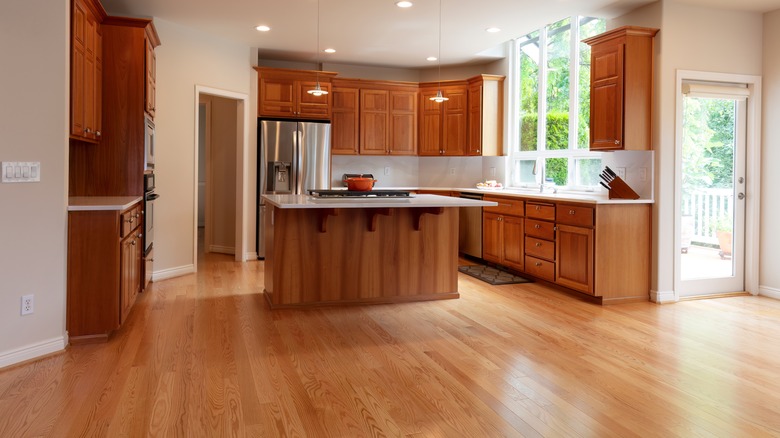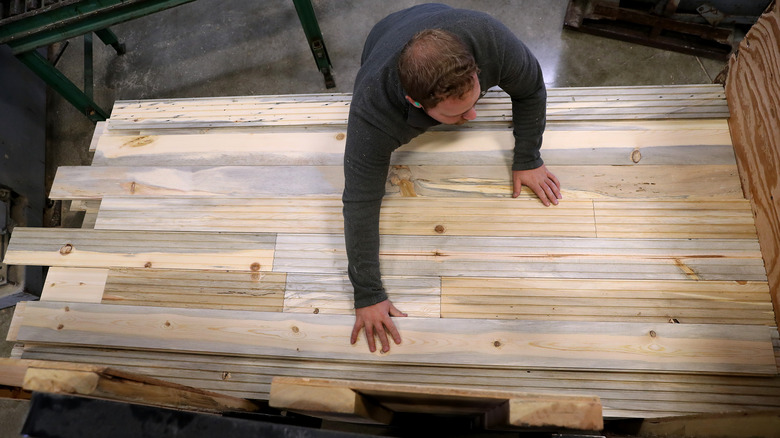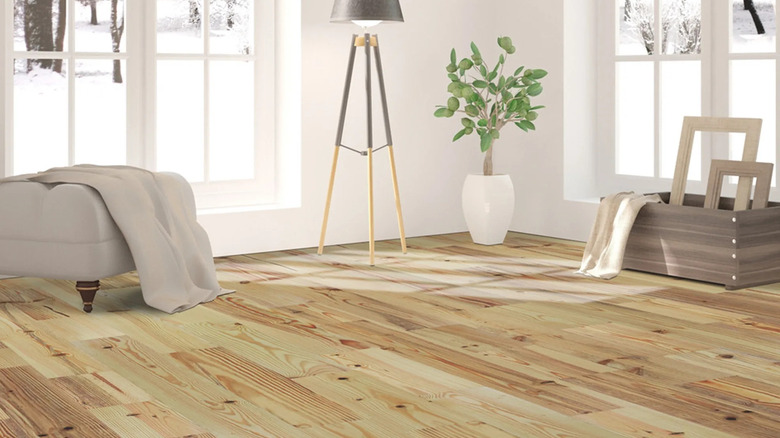The Big Difference Between Oak And Pine Hardwood Flooring You Should Know Before Buying
There's an excellent chance that, if you're inside a house as you read this, there's a lot of pine nearby. No, not trees — though you might have those, too. Your home's framing is likely made of some combination of pine, spruce, and fir lumber. It's probably in your plywood subfloor or your home's sheathing. It's almost certainly in your kitchen cabinets, and probably in your children's furniture, too. However, more than likely, it's not in your solid wood flooring — but that doesn't mean it can't be. Though it has the reputation of being an inexpensive softwood that's merely passable for a proper floor, there's a little more to the story that's worth knowing before making your final judgement call.
Practically speaking, the big difference between pine and oak is that pine is a softwood and oak is a hardwood. Hardwoods like oak are usually heavier, stronger, and denser than softwoods. They tend to be darker and have a more pronounced grain. Pine softwood, on the other hand, grows faster and is more sustainable. Softwoods also can be less expensive than hardwoods (but, more on that later). Overall, hardwood has the characteristics that people want underfoot, which is why experts anticipate that oak will be one of the most popular types of hardwood flooring in 2024. So, denser wood like oak is sold as flooring, and pine is usually relegated to framing lumber and furniture. But is the received wisdom that oak is hard and expensive, while pine is soft and cheap, really the whole truth?
Oak is slightly harder than pine
Oak is unquestionably harder than pine, but the hardness of oak doesn't automatically make pine too soft for flooring. According to Superior Hardwood Flooring, northern red oak is the flooring industry median for hardness, based on its Janka hardness rating of 1290, and is harder than all pines. (You should consult the Janka scale before buying any hardwood flooring for your kitchen or other high-traffic rooms.) Some argue that longleaf yellow pine, the hardest variety of pine commonly used for flooring (with a Janka rating of 870), is plenty hard enough.
While that is likely true, it's very worth noting that it shows wear quickly, so it won't be ideal where pristine condition is important, like your formal dining room. Deeper wear also means it happens faster, so avoid pine in heavy traffic areas like an entryway or a child's room, or under furniture that can dent and scratch floors. But in a den or bedroom, or anywhere under a rug, it should be plenty durable.
Is pine actually cheaper than oak?
So, the inevitable question is: If oak's hardness is great and pine's is merely passable, is pine actually cheap enough to justify using softwood for flooring? The answer is a surprising "probably not." Comparing similar pine flooring at Lowe's, Menard's and LL Flooring reveals that the cheapest unfinished yellow pine is actually more expensive than most unfinished red oak in comparable widths. Appearance-wise, yellow pine is most similar to utility-grade oak, which is about 35% cheaper than pine.
This surprise gets more eye-widening when you consider that pine, which will naturally have to be refinished more often due to its lower durability, costs about 35% more to refinish than oak, as softer woods require a more time-consuming and careful process. Since sanding is likely to be more aggressive when refinishing pine, the floors will also have to be replaced more often. Of course, your mileage might vary depending on where you shop and what exactly you're interested in. If you absolutely love the look or color of pine, or if you have a line on some affordable reclaimed heart pine, it might make a good choice for low-traffic areas. But, on the whole, oak is both a more durable and smarter long-term buy than pine.


